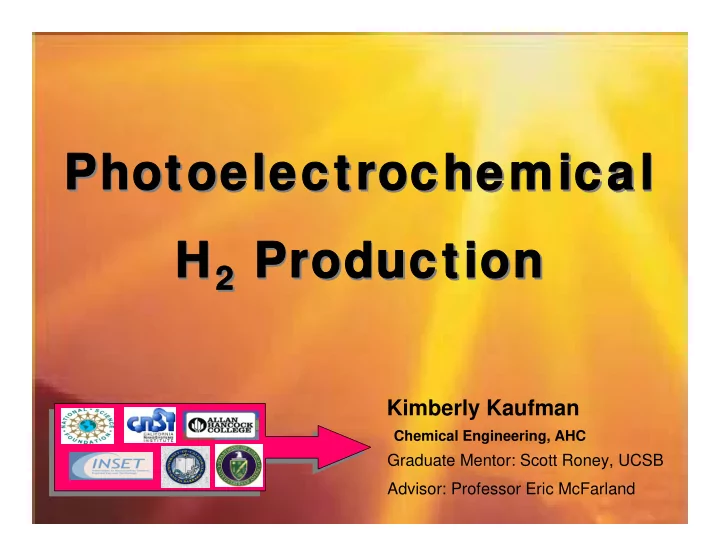

Photoelectrochemical Photoelectrochemical Photoelectrochemical Photoelectrochemical H 2 Production Production H 2 Production Production Kimberly Kaufman Chemical Engineering, AHC Graduate Mentor: Scott Roney, UCSB Advisor: Professor Eric McFarland
H 2 Production Production H 2 Production Production Clean renewable fuel Little H 2 in nature source decomposed H 2 O or High fuel value of hydrocarbons, fossil 142 kJ/g fuels Reduces the use of cost more energy to fossil fuels make Combustion expensive materials produces H 2 O for solar energy Gas-storage
Photovoltaic + Electrochemistry Photovoltaic
Solar Chemical Energy Energy 1972 Fujishima and Honda Photo-Electrochemical Cell 2 H + 2e - Cathode H 2 H 2 O anode 2h + ½ O 2 + 2 H + TiO 2 •Pure high quality H 2 Required expensive Pt catalyst Band gap too large for efficiency Poor solar absorption (UV only)
Practical H 2 from Photoelectrodes � must be inexpensive and stable � semiconductors with bandgaps in the energy range of visible light � potential cathode materials is Cu 2 O � Cu 2 O is prone to “photocorrosion” Cu 2 O-based heterojunction photocathode
Synthesis of Materials � Deposit Cu 2 O on FTO substrates � Cu 2 O easily reduces or oxidized � Current proportional Cu 2 O deposited Cu Lactate Ref Gnd Cntr Wkg Data Plate Digital Hotplate/stirrer 1 2 3 4 5 6 50ºC Plate 7 8 9 10 11 12 Target EXT Dummy Hot Plate Probe Sense PMC Potentiostat/galvanostat EG &G Princeton Applied Research Model 273A Diff. Electrometer I= E= Charge= Scan set up Control Mode Cell Current Output range On Reset Integral OFF
AIR � Protect integrity w/ Spray Pyrolysis of Zn acetate solution � Approximate thickness 200nm- 400nm Data Plate Digital � Annealing time 6-12 minutes Hotplate/stirrer 1 2 3 4 5 6 250˚ Plate Target 7 8 9 10 11 12 Hot Plate Probe PMC
Photocatalyst Screening Zero-bias photocurrent as a function of time e - A Light Off ("dark" current) 0.0 A - -0.5 D UV 2 ) Current (mA/cm Cut-off h + -1.0 D + Filter Light On -1.5 (anodic current) -2.0 Full Xe spectrum Photo-cathode -2.5 70 80 90 100 110 120 130 140 150 i Time (sec) 2 H + e - A ½ O 2 + 2 H + H 2 A - H 2 O h +
Photocurrent System Variable Flow Chemical Pump Filter Thermo Oriel wheel control COLEMAN Warning ! Potentiostat/Galvanostat 237A Xenon La Xen n Lamp HP Multimeter computerized N 2 drive Na acetate
Controlled Spray Pyrolysis Parameters : � 9.0 pH � Annealed 175˚C, 4hrs � -300 mV bias � ------- .4C --------.8C 100 .4C 100 .8C 80 80 60 60 .4C 40 .8C Current ( µ A) 40 20 20 Current ( µ A) 0 0 -20 -20 -40 -40 -60 -60 -80 -80 -100 -100 0 3 7 10 13 0 2 4 6 8 10 Time (min) Time (min) Cu 2 O w/ ZnO Cu 2 O only
Controlled Spray � 9.0 pH Pyrolysis Parameters : � Annealed 175˚C, 4hrs � -300 mV bias � Post annealed, 300˚C. 4hrs � ------- .4C --------.8C Cu 2 O only Cu 2 O w/ ZnO 100 100 50 50 0 0 Current ( µ A) Current ( µ A) -50 -50 -100 -100 -150 -150 -200 -200 0 3 7 10 0 3 7 10 Time (min) TIme (min)
Our Findings … ZnO films can be synthesized on electrodeposited Cu 2 O by spray pyrolysis Oxidation improved the photocurrent of the Cu 2 O ZnO may protect Cu 2 O from photocorrosion, depending on thickness Thicker ZnO layer causes anodic behavior Thicker Cu 2 O layer reduced the amount of photocurrent, electrons have too far to travel Annealing after spray pyrolysis improved the conductivity of the Cu 2 O
Special Thanks To: Scott Roney Kelsey Gorter Nick Tovar Alan Kleiman-Shwarcstein Eric McFarland Nick Arnold Mike Northen Trevor Hirst Liu-Yen Kramer Julie Niles & Judy
Future Works : Use applied potential during photocurrent between - 0.3V and -0.425V Make thinner ZnO layers (e.g. use more dilute spray solution) Try higher annealing temperature for Cu 2 O Refine higher-pH electrodeposition Measure thickness of ZnO and Cu 2 O layers using profilometer Characterize ZnO/Cu 2 O made by Atomic Layer Deposition (collaboration with Prof. Steve George at University of Colorado)
Recommend
More recommend